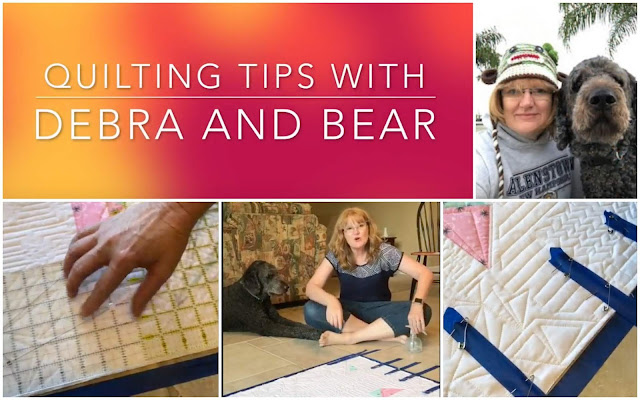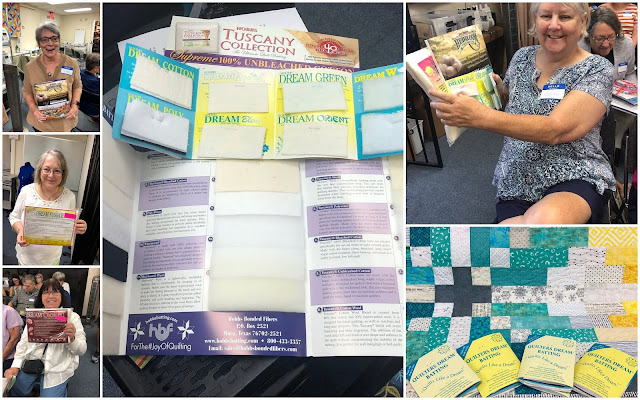
We had some very interesting demonstrations during our B4 and a Bear portion of our last meeting. For future reference, we are putting all the tips/technique here on its own blogpost.
B1 - Borders
Here are Beth’s tips for adding borders to a quilt without stretching or distortion:
Measure the middle of the quilt to get correct size for borders.
Pin borders in middle and end to be sure the piece isn't getting stretched as you stitch.
Find a full tutorial on Amy’s blog, Diary of a Quilter - here is the link.
B2 - Blocking with Debra and Bear
Debra, Quiltcon prize winner, shared her technique for blocking a quilt that isn't the exact size you planned once quilted.
This works if an edge is just fractions of an inch off.
Use painter’s tape to mark out the size your quilt should be on the floor.
Tape your quilt to the floor using painter's tape.
Using a squirt bottle, wet the area of the quilt that needs to be stretched.
Move into place, tape and let dry.
Here's the video Paula took of Debra’s demonstration, co-stared with Bear. Debra recommends blocking a quilt which is going to a show or for a wall-hanging.
B3 - Binding
There are many ways to bind a quilt, you just to have to find what works for you.
Here’s Alejandrina’s technique of finishing binding:
Overlap the beginning and end of binding by the same length as the width of the binding.
Use a clip to bunch up extra quilt to make it easier to connect the binding ends.
Open up the binding, right sides together, overlap the ends at a right angle.
Draw a diagonal across the stripes going from left to right, pin and check that it is the right direction.
Sew on the line, and cut off the excess of fabric.
Alejandrina's tip: use a large clip to gather and hold the quilt, reducing the bulk while finishing the binding (see picture above).
For a more visual tutorial, here is Mimi Dietrich illustrated method.
Mary Sm shared her technique for attaching binding, using a similar technique. However, once the two tails of the binding overlap, she marks the junction and cut the binding at a 45-degree-angle. Again, pictures being better than words, here is a tutorial found on Craftsy.
A flange binding will add a bit of flair to your quilt. Alissa shared her technique.
You need two colours for this binding. The main color of the binding is 1.5" wide and the flange fabric is 1.75" wide, both the length of the quilt perimeter.
Sew the 2 strips together.
Iron in half and sew to back of quilt and then flip to front.
Stitch on top with same color thread as flange.
Sew Fresh Quilts has this tutorial for the flange binding: here.
Linda did not like finishing her binding on the machine until she started using wash-away thread in her bobbin:
with the wash-away tread in her bobbin, she attached the binding on the back of the quilt.
then, replace the wash-away bobbin with bobbin with a regular thread, flip the binding, line up the edge of the binding with the line of wash-away stitches, and sew from the top.
once washed, the anchoring threat will dissolve, leaving just the top line of stitches.
Linda's tips: Do not forget to remove the wash-away bobbin! Do not use steam on your quilt until the binding is fully sewn in place! Keep your wash-way thread in an air-tight bag! Humidity will dissolve your thread.
If you prefer your binding to fold from front to back, you might be interested in this method using wash-away thread and cotton cord sewn in the binding.
Beth shared her technique of using the quilt backing for the binding.
Make the backing 1" larger on all sides.
Fold in half so it aligns with edge of quilt and then fold in half again and press.
Mark from edge of top and batting and measure 1" in and fold corner in and pin, then fold next edge over so you get a mitered corner.
A full tutorial of this binding method can be found here.
Looking for a technique for perfectly mitered corners, check
Linda's webinaron the Modern Quilt Guild (Linda,
@Flourishingpalms, is member of the Central Florida MQG)
B4 - Batting
Oh my! So many options. Thanks to Hobbs and Quilter's Dream, members present at the meeting received samples, and a few lucky ones won some batting to try out.
If you have more tips and techniques to share, please leave us a comment.






